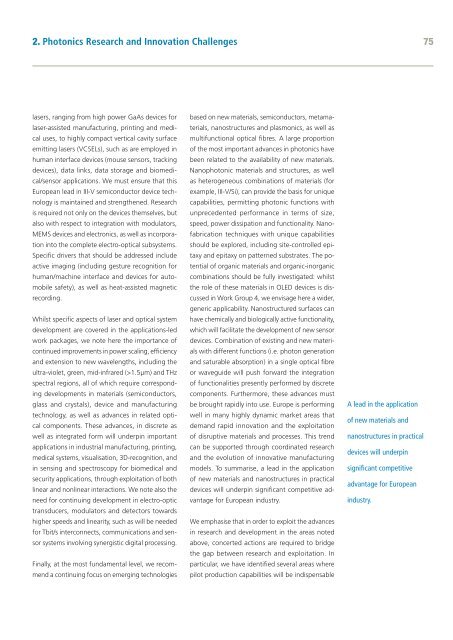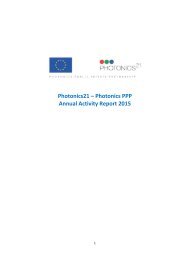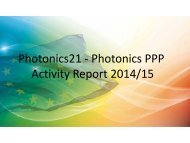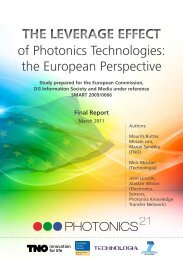Towards 2020 – Photonics driving economic growth in Europe
Create successful ePaper yourself
Turn your PDF publications into a flip-book with our unique Google optimized e-Paper software.
2. <strong>Photonics</strong> Research and Innovation Challenges<br />
75<br />
lasers, rang<strong>in</strong>g from high power GaAs devices for<br />
laser-assisted manufactur<strong>in</strong>g, pr<strong>in</strong>t<strong>in</strong>g and medical<br />
uses, to highly compact vertical cavity surface<br />
emitt<strong>in</strong>g lasers (VCSELs), such as are employed <strong>in</strong><br />
human <strong>in</strong>terface devices (mouse sensors, track<strong>in</strong>g<br />
devices), data l<strong>in</strong>ks, data storage and biomedical/sensor<br />
applications. We must ensure that this<br />
<strong>Europe</strong>an lead <strong>in</strong> III-V semiconductor device technology<br />
is ma<strong>in</strong>ta<strong>in</strong>ed and strengthened. Research<br />
is required not only on the devices themselves, but<br />
also with respect to <strong>in</strong>tegration with modulators,<br />
MEMS devices and electronics, as well as <strong>in</strong>corporation<br />
<strong>in</strong>to the complete electro-optical subsystems.<br />
Specific drivers that should be addressed <strong>in</strong>clude<br />
active imag<strong>in</strong>g (<strong>in</strong>clud<strong>in</strong>g gesture recognition for<br />
human/mach<strong>in</strong>e <strong>in</strong>terface and devices for automobile<br />
safety), as well as heat-assisted magnetic<br />
record<strong>in</strong>g.<br />
Whilst specific aspects of laser and optical system<br />
development are covered <strong>in</strong> the applications-led<br />
work packages, we note here the importance of<br />
cont<strong>in</strong>ued improvements <strong>in</strong> power scal<strong>in</strong>g, efficiency<br />
and extension to new wavelengths, <strong>in</strong>clud<strong>in</strong>g the<br />
ultra-violet, green, mid-<strong>in</strong>frared (>1.5μm) and THz<br />
spectral regions, all of which require correspond<strong>in</strong>g<br />
developments <strong>in</strong> materials (semiconductors,<br />
glass and crystals), device and manufactur<strong>in</strong>g<br />
technology, as well as advances <strong>in</strong> related optical<br />
components. These advances, <strong>in</strong> discrete as<br />
well as <strong>in</strong>tegrated form will underp<strong>in</strong> important<br />
applications <strong>in</strong> <strong>in</strong>dustrial manufactur<strong>in</strong>g, pr<strong>in</strong>t<strong>in</strong>g,<br />
medical systems, visualisation, 3D-recognition, and<br />
<strong>in</strong> sens<strong>in</strong>g and spectroscopy for biomedical and<br />
security applications, through exploitation of both<br />
l<strong>in</strong>ear and nonl<strong>in</strong>ear <strong>in</strong>teractions. We note also the<br />
need for cont<strong>in</strong>u<strong>in</strong>g development <strong>in</strong> electro-optic<br />
transducers, modulators and detectors towards<br />
higher speeds and l<strong>in</strong>earity, such as will be needed<br />
for Tbit/s <strong>in</strong>terconnects, communications and sensor<br />
systems <strong>in</strong>volv<strong>in</strong>g synergistic digital process<strong>in</strong>g.<br />
F<strong>in</strong>ally, at the most fundamental level, we recommend<br />
a cont<strong>in</strong>u<strong>in</strong>g focus on emerg<strong>in</strong>g technologies<br />
based on new materials, semiconductors, metamaterials,<br />
nanostructures and plasmonics, as well as<br />
multifunctional optical fibres. A large proportion<br />
of the most important advances <strong>in</strong> photonics have<br />
been related to the availability of new materials.<br />
Nanophotonic materials and structures, as well<br />
as heterogeneous comb<strong>in</strong>ations of materials (for<br />
example, III-V/Si), can provide the basis for unique<br />
capabilities, permitt<strong>in</strong>g photonic functions with<br />
unprecedented performance <strong>in</strong> terms of size,<br />
speed, power dissipation and functionality. Nanofabrication<br />
techniques with unique capabilities<br />
should be explored, <strong>in</strong>clud<strong>in</strong>g site-controlled epitaxy<br />
and epitaxy on patterned substrates. The potential<br />
of organic materials and organic-<strong>in</strong>organic<br />
comb<strong>in</strong>ations should be fully <strong>in</strong>vestigated: whilst<br />
the role of these materials <strong>in</strong> OLED devices is discussed<br />
<strong>in</strong> Work Group 4, we envisage here a wider,<br />
generic applicability. Nanostructured surfaces can<br />
have chemically and biologically active functionality,<br />
which will facilitate the development of new sensor<br />
devices. Comb<strong>in</strong>ation of exist<strong>in</strong>g and new materials<br />
with different functions (i.e. photon generation<br />
and saturable absorption) <strong>in</strong> a s<strong>in</strong>gle optical fibre<br />
or waveguide will push forward the <strong>in</strong>tegration<br />
of functionalities presently performed by discrete<br />
components. Furthermore, these advances must<br />
be brought rapidly <strong>in</strong>to use. <strong>Europe</strong> is perform<strong>in</strong>g<br />
well <strong>in</strong> many highly dynamic market areas that<br />
demand rapid <strong>in</strong>novation and the exploitation<br />
of disruptive materials and processes. This trend<br />
can be supported through coord<strong>in</strong>ated research<br />
and the evolution of <strong>in</strong>novative manufactur<strong>in</strong>g<br />
models. To summarise, a lead <strong>in</strong> the application<br />
of new materials and nanostructures <strong>in</strong> practical<br />
devices will underp<strong>in</strong> significant competitive advantage<br />
for <strong>Europe</strong>an <strong>in</strong>dustry.<br />
We emphasise that <strong>in</strong> order to exploit the advances<br />
<strong>in</strong> research and development <strong>in</strong> the areas noted<br />
above, concerted actions are required to bridge<br />
the gap between research and exploitation. In<br />
particular, we have identified several areas where<br />
pilot production capabilities will be <strong>in</strong>dispensable<br />
A lead <strong>in</strong> the application<br />
of new materials and<br />
nanostructures <strong>in</strong> practical<br />
devices will underp<strong>in</strong><br />
significant competitive<br />
advantage for <strong>Europe</strong>an<br />
<strong>in</strong>dustry.






